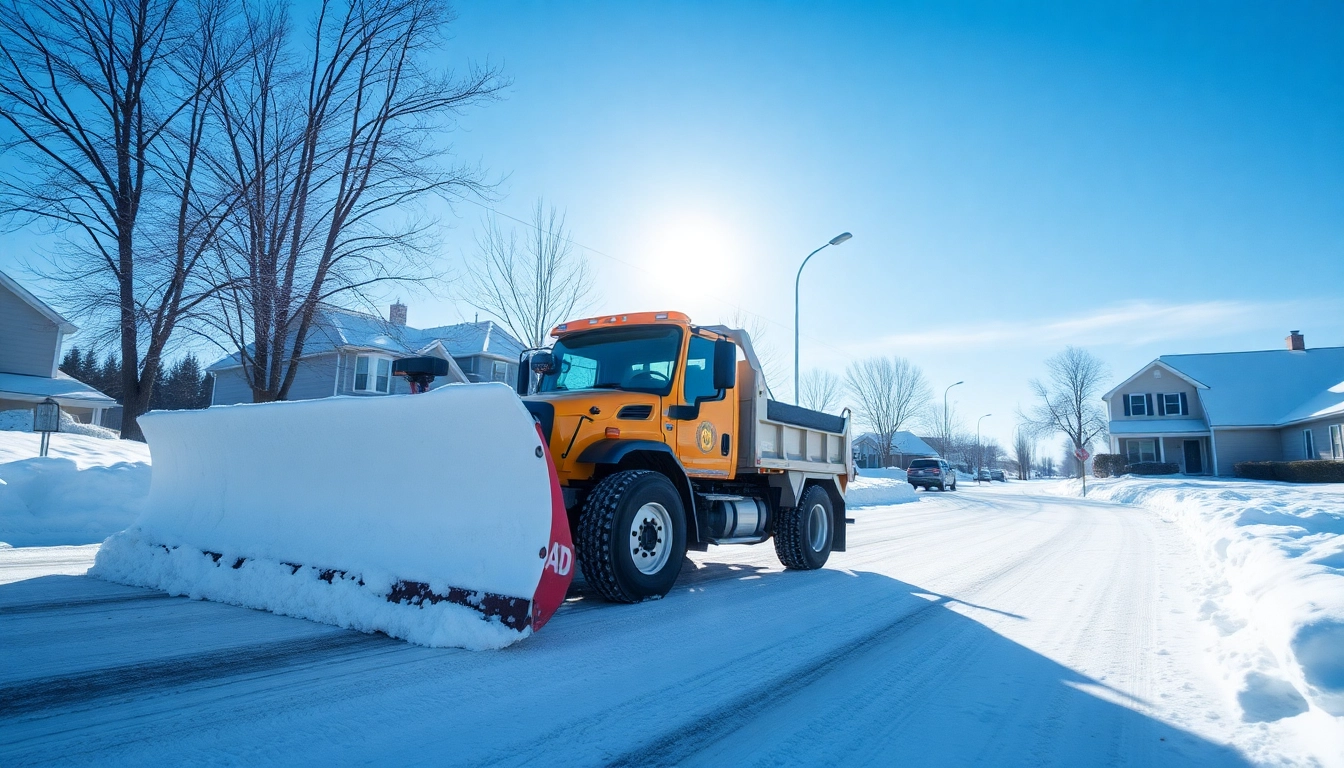Understanding the Basics of Snow Plowing
As winter descends upon us with its blanket of snow, the importance of snow plowing becomes undeniable. Efficiently managing the accumulation of snow on roads, driveways, and sidewalks is vital for maintaining accessibility and safety during the colder months. When strategically implemented, snow plowing not only enhances mobility but also reduces the risk of accidents caused by hazardous conditions. In this article, we will explore the fundamental aspects of snow plowing, including its significance, operational mechanics, and various methods used in the industry.
The Importance of Snow Plowing
Snow plowing serves several critical functions that contribute to public safety, economic stability, and community well-being. Municipalities and private entities rely on snow plowing to:
- Ensure Safe Travel: Clear roadways minimize the likelihood of accidents by providing a safe path for vehicles and pedestrians.
- Support Emergency Services: Unobstructed roads are essential for emergency responders to reach those in need during severe weather.
- Promote Economic Activity: Businesses depend on accessible roads for customers and deliveries, making effective snow plowing vital to economic resilience.
- Maintain Quality of Life: Accessible neighborhoods allow residents to go about their daily routines, ensuring that public services, schools, and shops can operate smoothly.
How Snow Plowing Works
The snow plowing process generally unfolds in several stages to maximize efficiency and effectiveness:
- Forecasting: Plow operators monitor weather conditions and forecasts to anticipate snowfall and prepare resources accordingly.
- Preparation: Vehicles and equipment are readied, including attaching plows, filling salt spreaders, and ensuring all machinery is functional.
- Plowing: As snow begins to accumulate, plows are deployed to push snow to the side of the road, creating a clear lane for traffic.
- Post-Plowing Maintenance: Additional treatments such as salt and sand are often applied to enhance traction and prevent ice formation.
Types of Snow Plowing Methods
Different plowing strategies are utilized based on the severity of snow, the terrain, and the specific requirements of the area being serviced:
- Standard Plowing: This involves using traditional snow plows to push snow aside, typically seen on roads and highways.
- Sidewalk and Pathway Clearing: Narrower plows or shoveling techniques are used to ensure pedestrians can safely navigate spaces not accessible by vehicles.
- Snow Relocation: In some cases, particularly after major storms, snow may be moved to a designated area rather than simply pushed aside, ensuring that highways remain clear.
- Blowing and Vacuuming: Advanced techniques that involve snow blowers or vacuum trucks can be employed in sensitive areas where snow must be removed rather than relocated.
Essential Equipment for Snow Plowing
Effective snow plowing hinges on utilizing the right equipment, which can vary based on the scale of the operation, the nature of the terrain, and the specific service requirements. Here, we detail the essential gear needed for snow plowing:
Snow Plows and Their Functions
Snow plows are the primary tool for plowing operations. Different types of plows serve various functions:
- Straight Plows: These are simple blades that push snow away from the traveled surface and are commonly mounted on trucks.
- V-Plows: V-shaped plows allow for more effective snow removal, especially in heavy accumulations, by pushing snow to the sides as well as forward.
- Box Plows: Best for larger commercial operations, these plows have a box-like structure that collects snow and can be used for transport.
- Angle Plows: Useful for adjusting the direction of the snow being pushed, enhancing operational efficiency.
Safety Gear for Plow Operators
For snow plow operators, safety is paramount. Essential safety gear includes:
- Reflective Vests: High-visibility clothing ensures operators are seen, especially during low-light conditions.
- Winter Boots: Insulated, water-resistant footwear helps prevent slips and maintain warmth.
- Hearing Protection: Since plowing can be noisy, ear protection is advised to prevent long-term hearing loss.
- Gloves and Hand Warmers: Adequate hand protection is crucial for operating controls effectively in cold climates.
Maintaining Snow Plow Vehicles
Maintenance of snow plow vehicles is essential for optimal performance during snow events:
- Regular Inspections: Checking plow blades, hydraulic systems, and engine fluids before winter is critical.
- Winter Preparedness: Equipping vehicles with winter tires and maintaining battery health helps prevent breakdowns.
- Post-Season Checks: After winter, cleaning equipment and checking for wear and tear enables readiness for future snow seasons.
Best Practices for Effective Snow Plowing
To optimize the snow plowing process, following best practices can lead to improved outcomes:
Planning Your Plowing Routes
Successful snow plowing begins with effective planning:
- Route Optimization: Employing technology to create efficient routes reduces unnecessary travel and improves response times.
- Prioritization: Main roads and thoroughfares should be plowed first, followed by secondary routes and residential areas.
- Mapping Tools: Utilizing GIS technology aids in visualizing snow accumulation and potential plowing challenges.
Timing and Frequency of Snow Plowing
Determining when and how often to plow is crucial for effectiveness:
- Immediate Response: Plowing should ideally commence as soon as the snow begins to accumulate.
- Frequent Monitoring: Regular checking of conditions allows operators to adjust plowing schedules based on changing weather patterns.
- Continuous Operations: During heavy snowfall, continuous plowing may be necessary to keep pathways manageable.
How to Handle Heavy Snowfalls
In cases of heavy snowfall, specific strategies come into play:
- Enhanced Staffing: Increasing the number of plow operators can help manage larger areas more effectively.
- Multi-Vehicle Coordination: Utilizing a coordinated fleet of plows can assist in tackling significant accumulations.
- Temporary Road Closures: In extreme cases, temporarily closing roads while plowing can minimize congestion and facilitate safer snow removal.
The Difference Between Snow Plowing and Snow Removal
It’s crucial to differentiate between snow plowing and snow removal, as both services serve unique purposes:
Understanding Snow Plowing Services
Snow plowing is primarily about pushing snow off of surfaces to create pathways, maintaining accessibility:
- Surface Management: Snow remains in proximity until warmer conditions cause melting.
- Cost-Efficiency: Generally less expensive than snow removal since it doesn’t involve carting snow away.
- Common for Roads: Ideal for keeping roads and parking lots clear during snowfall.
When to Choose Snow Removal Over Plowing
Snow removal involves taking snow away entirely, common in constrained spaces:
- Property Management: Necessary for residential and commercial properties with limited space for snow accumulation.
- Final Clean-Up: Often conducted after a heavy plow event to manage excessive snow loads.
- Enhancing Safety: Complete snow removal can reduce slip-and-fall hazards and improve overall safety.
Regulations on Snow Management
Local laws often dictate duties regarding snow management:
- Property Owner Responsibility: Many municipalities require homeowners to clear sidewalks and driveways in a timely manner.
- Permit Regulations: Snow removal operations may require permits, especially for large-scale third-party services.
- Compliance with Local Codes: Understanding local snow removal regulations is essential for efficient and lawful operations.
Cost Considerations for Snow Plowing Services
When assessing snow plowing services, cost efficiency and budgeting are paramount:
Average Costs of Snow Plowing
The cost of snow plowing can vary significantly based on location, service types, and the overall market:
- Standard Fees: On average, residential snow plowing costs range from $45 to $160 per visit.
- Seasonal Contracts: For regular services through the winter months, prices often fall between $300 to $1,000.
- Special Situations: Heavy snowfalls or late-night plowing may incur additional costs, adjustable based on the service agreement.
Factors Influencing Snow Plowing Prices
Multiple variables can impact the pricing of snow plowing services:
- Geographical Location: Urban centers tend to have higher rates due to demand and competition.
- Accessibility: Areas requiring special equipment or multiple trips may bear higher costs.
- Service Frequency: Contracts guaranteeing regular services might offer discounted rates, while pay-per-service is typically pricier.
- Snow Accumulation: Increased snow depth often requires more time and resources, leading to higher fees.
Budgeting for Seasonal Snow Management
Creating a budget for snow plowing services can help in planning for winter expenses:
- Estimate Snowfall: Analyzing average snowfall in your region can help forecast expected plowing needs.
- Set Aside Funds: Allocating a specific percentage of your winter budget for snow removal can alleviate sudden financial strain.
- Evaluate Service Needs: Regularly assess the effectiveness and necessity of services, enabling informed adjustments to your plan.


